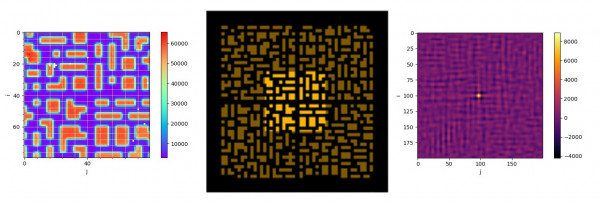First image of ECLAIRs
The ECLAIRs instrument has produced its first image. After years of development by the APC, CEA, IRAP and CNES teams, and after several months of integration during which the different elements of the telescope were progressively assembled around the detection plane, the ECLAIRs instrument has just produced its first image. This is a major step in the characterization of the instrument.

This first image shows the coded mask shadow projected on the detection plane. The sources being placed at a few tens of centimeters and not at infinity, the mask is magnified and only its central part is imaged.
This image was obtained with the telescope installed in a vacuum tank, in order to be able to cool the detection plane to -25 °C. Two radioactive sources installed in the tank illuminated the detector through the mask. Outside the tank, the computer in charge of driving the camera and acquiring data will also allow the detection of gamma-ray bursts when the instrument is in flight.
This image also kicks off the last phase of calibration of the instrument. This phase, which mobilizes all the technical and scientific teams, including in 3×8 and 7 days a week for some, will continue until the end of May.
IRAP Contact
- Jean-Luc Atteia, Jean-Luc.Atteia@irap.omp.eu






